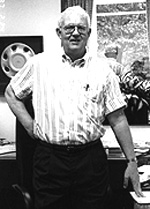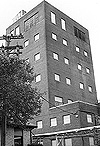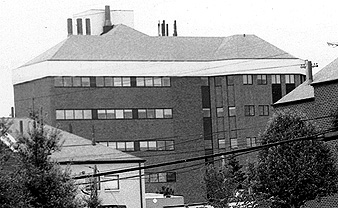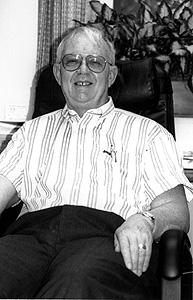
| T H E N I H C A T A L Y S T | J U L Y – A U G U S T 1997 |
|
|
|
BUILD IT AND THEY WILL COME:NCI-FREDERICK'S FIELD OF DREAMS |
text and photos |
 |
|
Donald
Summers
|
Donald Summers has visions of implosion when he glances up at the building just behind his office. Since Summers became the new scientific coordinator of the Frederick Cancer Research and Development Center last January, he has resented the looming tower that dominates part of the skyline at the NCI’s "outpost" on the grounds of Fort Detrick, 37 miles from the Bethesda campus, in Frederick, Maryland.
 |
|
|
The
Old Tower
|
And he wants the "tower," as the now-deserted building is indeed called, torn down. Not only does it cast a shadow over his personal workplace, it’s a symbol of the past, a reminder that biological warfare was once the focus of the research conducted at the Army’s Biological Defense Research Laboratories—the predecessor of the civilian FCRDC.
That image bears no resemblance to Frederick’s face today or to the future Frederick evolving in Summers’ mind.
"When people think basic science research in cancer and AIDS, they’ll think Frederick," he says, projecting a picture of the FCRDC as a "center of excellence that attracts the upper 0.001 percent of internationally recognized scientists." That projection, he adds, merely builds upon Frederick’s current, high-calibre research climate.
Clinical research, however, is no longer on the Frederick agenda. With the changing of the NIH guard—the arrival of Harold Varmus as NIH director and the appointment of Richard Klausner as NCI director—"there was a decision to redirect the function, focus, and future goals, of the Frederick facility," Summers said in an interview with The NIH Catalyst during the first Frederick Research Festival (see "All's Fair at Frederick"). The Bishop-Calabresi report, released in June 1995, also recommended consolidating NCI’s clinical research activities in Bethesda.
With the aid of an advisory committee of preeminent scientists from across the country and a "space" committee a little closer to home, Summers is reconceptualizing Frederick’s programs and facilities to better advance the basic-research directive. His quest for internationally recognized scientists is already amply satisfied by the individuals now on the FCRDC roster, he observed, citing: "Steve O’Brien, whose work on AIDS and evolutionary mammalian genetics is world-renowned; Steve Hughes, who’s worked out the X-ray crystal structure of an HIV protein; John Coffin, who we’ve recruited and who’ll be coming here from Tufts August 1—spending 40 percent of his time here—to conduct his research on resistant mutants of HIV. We’re wooing a smart, young scientist who has a spectacular way to look at human genetics. . . ."
 |
|
FCRDC’s
new Building 535, five floors of labs dedicated predominantly to AIDS
research.
|
Summers pointed with pride to Building 535, visible in the distance from his administrative enclave. "We built that new building—completed last year, with five floors of laboratories for AIDS research. That’s the building where Larry Arthur is doing his great AIDS vaccine research; that’s the building we had for John Coffin to come to."
"That modern, research-lab building is giving John Coffin the facilities to expand his research, a place to have close interactions with other molecular biology experts in the HIV field. If you have facilities, you have scientists; if you have scientists, you get ideas. I’d like to have visiting scientists come here and spend a year—to give them a lab and a place to live," Summers asserted, dismissing a question about whether it is duplicative to have both Building 535 in Frederick and the projected new center on the Bethesda campus mentioned by President Clinton as home to an expanded AIDS-vaccine research effort.
"It’s not overkill, and it’s not greed. It will create an atmosphere to heighten the dialogue—scientific dialogue, hard to define but an incredibly important part of science. There will be lots of cooperation between David Baltimore (president of CalTech and chairman of the NIH AIDS Vaccine Research Committee) and people like Steve Hughes and John Coffin," Summers said (see "Forces Coalescing").
Even in the realm of clinical research, even with no patients at FCRDC, there will be ties between Bethesda and Frederick. For instance, Summers said, the latter will be the site of DNA-sequence libraries in connection with cells taken from cancer patients by use of the laser-capture microdissection technique invented by NCI’s Lance Liotta and colleagues (see The NIH Catalyst, November–December 1997, "Hot Methods"). Analysis of materials from patients in clinical trials will also continue to be performed at Frederick, and research that uses human materials, such as O’Brien’s use of serum samples in tracking down a genetic locus that conferred resistance to HIV, will certainly proceed. There is still a place for "clinically related translational research," as well as programs to screen natural products for therapeutic potential, Summers said, observing that there is "now such a close relationship between basic, translational, clinical, and applied research."
 |
|
"If you have facilities, you have scientists; if you have scientists, you get ideas"—Donald Summers |
He’s a bit circumspect discussing some of the specific relocation recommendations in the Bishop-Calabresi report, as well as the status of Frederick’s support services (such as mass spectrometry, high-performance supercomputing, amino acid sequencing, and many others). "There’s a reevaluation across the board of what NCI is all about," he said.
The recommended relocation of the clinical research branch of the former Biological Response Modifiers Program has already occurred, but Summers was not so sanguine regarding another suggestion—that the Applied BioSciences Laboratories also be moved.
"ABL is an outstanding group of scientists assembled here by George Vande Woude, on contract. I hope it’s not going to happen; I think it’s much too valuable a resource to mess with it," he said, adding that cooperation among NCI, ABL, and SAIC (Science Applications International Corporation), the contractor that runs ABL, is increasing.
The distance between Frederick and Bethesda—indeed, between Frederick and anywhere in the world—however, is shrinking, Summers said, thanks to such technologic capabilities as the computer-television—"picture-tel"—he had installed in his office two weeks earlier.
"I can punch a button and talk to John Coffin in Boston, see him, show him data, and transfer his data to Munich, Germany. It’s a picture communications system hooked up through a p.c., and now there’s a network available through a master server at NIH. I’m installing these in offices in Building 31 and in another federal building where the special biotech assistants to Rick Klausner have their offices."
Summers wants nothing short of FCRDC’s becoming "the most predictive biotech operation. We want to be a year ahead of the state-of-the-art. So we’re asking people from industry and the universities to come here and talk to us. We’re working with them to rebuild this place in the right way. Should we have a supercomputer to study the structure of proteins and genes and chemicals? Absolutely. Francis [Collins] will sequence the human genome. We’re going to do mouse, fly, and worm. That’s an overwhelming amount of information. If we need core facilities, we’ll get core facilities; if we need people with certain expertise, we’ll work to recruit them."
"Come back in another
half-year or year," he suggested, "and see how we look." ![]()
|
Moving Gains Far Outweigh the Pains It took Larry Kwak one month to move his clinical cancer-vaccine protocols and his patients from Frederick to the Clinical Center in Bethesda."There are always moving pains, but basically, we have reproduced everything from up here to down there, and things are running very smoothly," Kwak, a principal investigator in NCI’s Medicine Branch, told The NIH Catalyst. He has been conducting clinical tests of vaccines against lymphoma and multiple myeloma since 1992. The transition involved a loss of clinical nursing and administrative staff expertise in Frederick, which was unfortunate, and the training of Bethesda-based personnel was required to meet the needs of the protocols, a process that took about six months. In no way, however, did it discomfort any patients, Kwak said. "All 80 patients, without exception, have been accommodated, and there is great intellectual and scientific advantage in our being there, both for our program and for the Clinical Center," he said. "I really am very satisfied with this transition and what it means for our patients and our program." Kwak spends one
day a week at the Clinical Center and the rest of his time in Frederick,
running his research lab in the Department of Experimental Transplantation
and Immunology in the Division of Clinical Sciences. His research focuses
on second-generation cancer-vaccine development and human tumor immunology.
–F. P. |